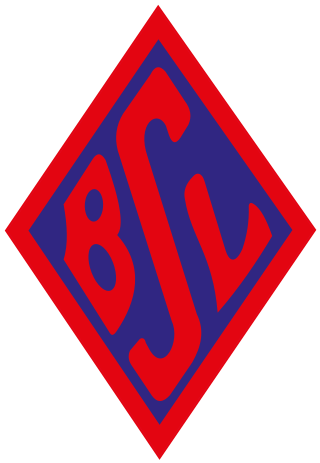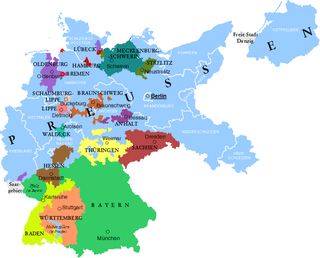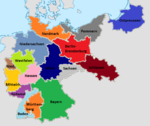
SV Arminia Hannover is a German association football club based in Hanover, Lower Saxony.

ATSV 1860 Bremen was a German association football club playing in Bremen. Today the sports club no longer fields a football side and has departments for badminton, basketball, cheerleading, dancing, fencing, handball, Judo, Karate, pool-billiards, rhythmic gymnastics, rugby union, skating, Taekwon-do, and volleyball.

VfB Rot-Weiß 04 Braunschweig is a German association football club from the city of Braunschweig in Lower Saxony and is part of a larger sports club with departments for women's and youth football, gymnastics, team handball, table tennis, tennis, volleyball.
The Oberliga Nord was the highest level of the German football league system in the north of Germany from 1947 until the formation of the Bundesliga in 1963. It covered the states of Lower Saxony, Bremen, Hamburg and Schleswig-Holstein.

The Oberliga Niedersachsen, sometimes referred to as Niedersachsenliga, is the fifth tier of the German football league system and the highest league in the German state of Lower Saxony. Since 1994, the league was split into a western and an eastern group. In 2010, it returned to a single-division format. The Oberliga moved to a north-south split for one season in 2020. It is one of fourteen Oberligen in German football, the fifth tier of the German football league system.

A Gauliga was the highest level of play in German football from 1933 to 1945. The leagues were introduced in 1933, after the Nazi takeover of power by the National Socialist League of the Reich for Physical Exercise.

The Gauliga Mittelrhein was the highest football league in the central and southern part of the Prussian Rhine Province from 1933 to 1945. Shortly after the formation of the league, the Nazis reorganised the administrative regions in Germany, and the GaueKöln-Aachen and Moselland replaced the Prussian province in the Middle Rhine region.

The Gauliga Nordmark was the highest football league in the Prussian Province of Schleswig-Holstein and the German states of Hamburg, Lübeck, Mecklenburg-Schwerin, Mecklenburg-Strelitz and parts of Oldenburg from 1933 to 1945. Shortly after the formation of the league, the Nazis reorganised the administrative regions in Germany, and the GaueHamburg, Mecklenburg and Schleswig-Holstein replaced the Prussian province and the German states in this northern region of Germany.

SV Algermissen is a German football club from the village of Algermissen, Lower Saxony near Hannover. The club was established 5 May 1911 as Fußball-Club Britannia Algermissen. The name Britannia was popular among early German clubs in acknowledgment of the origins of the sport in Great Britain, but fell out of favour after World War I. On 26 December 1918 the club was renamed Sportverein Algermissen 11.

The Goslarer SC 08 is a German association football club from the city of Goslar, Lower Saxony.
The Landesliga Weser-Ems, called the Bezirksoberliga Weser-Ems from 1979 to 1994 and 2006 to 2010, is the sixth tier of the German football league system and the second highest league in the German state of Lower Saxony (German:Niedersachsen). It covers the region of the now defunct Regierungsbezirk Weser-Ems.
The Landesliga Hannover, called the Bezirksoberliga Hannover from 1979 to 1994 and 2006 to 2010, is the sixth tier of the German football league system and the second highest league in the German state of Lower Saxony. It covers the region of the now defunct Regierungsbezirk Hanover.
The Landesliga Braunschweig, called the Bezirksoberliga Braunschweig from 1979 to 1994 and 2006 to 2010, is the sixth tier of the German football league system and the second highest league in the German state of Lower Saxony. It covers the region of the now defunct Regierungsbezirk Braunschweig.
The Landesliga Lüneburg, called the Bezirksoberliga Lüneburg from 1979 to 1994 and 2006 to 2010, is the sixth tier of the German football league system and the second highest league in the German state of Lower Saxony (German:Niedersachsen). It covers the region of the now defunct Regierungsbezirk Lüneburg.

Blumenthaler SV is a German association football club from Blumenthal, the northernmost district of the city of Bremen. The club was established 6 June 1919 as Blumenthaler Sportverein by former members of Blumenthaler Fußballverein 1912. FV was the successor to Spiel- und Sport Blumenthal and is part of the historical tradition of SG Aumund-Vegesack, which is still active today. As a worker's club, SV was part of the Arbeiter-Turn- und Sportbund (ATSB) in the 1920s and early 1930s. The first men's soccer team plays in the fifth-class "Bremen Liga".
TS Woltmershausen is a German association football club from Woltmershausen, a district in the centre of the city of Bremen.

The Oberliga Südhannover/Braunschweig, also known as Südkreisliga and Bezirksliga Südhannover/Braunschweig at various points, was one of several first tier association football leagues in Germany from 1921 to 1933. The league covered the Free State of Brunswick and the southern part of the Prussian Province of Hanover.
The Verbandsliga Norddeutschland was one of several association football first tier leagues in the German Empire. The league only existed for one season and covered the area administered by the Northern German Football Association.

The 1942–43 Gauliga was the tenth season of the Gauliga, the first tier of the football league system in Germany from 1933 to 1945. It was the fourth season of the league held during the Second World War.

Hannoverscher Sport-Club von 1893 e.V., commonly referred to as Hannoverscher SC or HSC Hannover, is a German association football club from Hanover, Lower Saxony. Hannoverscher SC play in the Regionalliga Nord, the fourth tier in the German football league system, having been promoted from the Oberliga Niedersachsen in 2019.











